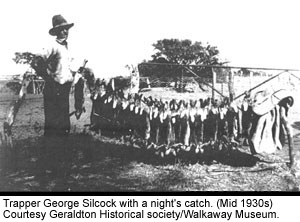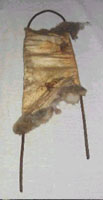|
 Hunting
rabbits was a common practice not only for landowners, but also local
townsfolk. "It sounds ridiculous, I know, but it was a sort of evening's
entertainment in those days, to go out and see who could catch the most
rabbits!" says Lynette Gillam. Hunting
rabbits was a common practice not only for landowners, but also local
townsfolk. "It sounds ridiculous, I know, but it was a sort of evening's
entertainment in those days, to go out and see who could catch the most
rabbits!" says Lynette Gillam.
Children would trap rabbits for pocket-money. Charlie
Ellery recalls: "I started off rabbit hunting when I was about twelve
- I was still going to school. With traps, you just put a piece of paper
over the top and cover them right over with sand. We had to go 'round
the traps a couple of times at night, otherwise you'd go 'round in the
morning and there'd be nothing left of them. Foxes used to eat them."
|
|
Angus Forsyth speaks about hunting rabbits with his
brothers during the 1930's.

|
During the Depression, shooting rabbits was an expensive
option, so other methods were used. Angus Forsyth recalls: "We did
our hunting with spades or mattocks - to dig them out. You always had
a dog with you. It was quite a thing, in our family! Not only that, we
were encouraged to do it because of the damage they were doing to the
crops."
 Trappers,
or 'Rabbiters' trapped rabbits commercially for their skins and their
meat. This was a common practice during the 1930's and 40's. A rabbit
would sell for two shillings (twenty cents) and at one stage, the rabbit
pelts were worth more than sheepskins! The 'skin merchant' from Geraldton
would visit Dongara every fortnight and collect the dried rabbit skins,
which would be left hanging by the side of the road. Trappers,
or 'Rabbiters' trapped rabbits commercially for their skins and their
meat. This was a common practice during the 1930's and 40's. A rabbit
would sell for two shillings (twenty cents) and at one stage, the rabbit
pelts were worth more than sheepskins! The 'skin merchant' from Geraldton
would visit Dongara every fortnight and collect the dried rabbit skins,
which would be left hanging by the side of the road. 
The pelts were processed into fur felt, and made into slouch hats worn
by the Australian Diggers in World War II. Even today, Akubra hats are
made from rabbit fur felt.
In August 1936, the Western Mail featured an article
on the correct method for preparing rabbit skins for sale. "The skins
are not pegged out, but 'sleeved'. A cut is made from one hind foot to
the other when skinning, and the pelt is drawn off like a sleeve. The
frames are best made from thick hard wire. The old heavy gauge black wire
is best, as it is springy. The skin is placed on, ... being placed from
belly to back. If the hind legs are tied together the skin does not shrink
and lose shape when it dries. Paint with weevil paint and allow to hang
in a shady place until quite dry."
|

 Hunting
rabbits was a common practice not only for landowners, but also local
townsfolk. "It sounds ridiculous, I know, but it was a sort of evening's
entertainment in those days, to go out and see who could catch the most
rabbits!" says Lynette Gillam.
Hunting
rabbits was a common practice not only for landowners, but also local
townsfolk. "It sounds ridiculous, I know, but it was a sort of evening's
entertainment in those days, to go out and see who could catch the most
rabbits!" says Lynette Gillam.  Trappers,
or 'Rabbiters' trapped rabbits commercially for their skins and their
meat. This was a common practice during the 1930's and 40's. A rabbit
would sell for two shillings (twenty cents) and at one stage, the rabbit
pelts were worth more than sheepskins! The 'skin merchant' from Geraldton
would visit Dongara every fortnight and collect the dried rabbit skins,
which would be left hanging by the side of the road.
Trappers,
or 'Rabbiters' trapped rabbits commercially for their skins and their
meat. This was a common practice during the 1930's and 40's. A rabbit
would sell for two shillings (twenty cents) and at one stage, the rabbit
pelts were worth more than sheepskins! The 'skin merchant' from Geraldton
would visit Dongara every fortnight and collect the dried rabbit skins,
which would be left hanging by the side of the road. 